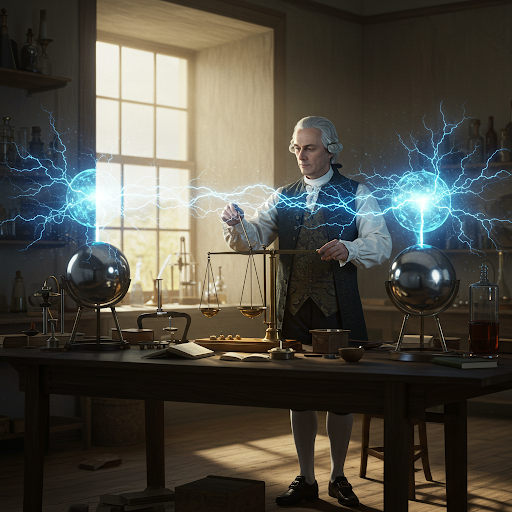The Force of Attraction and Repulsion: Unraveling the Invisible Forces of Electricity.
1785, Paris. A dimly lit laboratory, where the secrets of electricity are being unveiled through meticulous experimentation. The air crackles with static electricity, and the faint hum of the torsion balance fills the room.
Coulomb, his brow furrowed in concentration, observes the delicate dance of the charged spheres. “Observe,” he declares, his voice a low murmur, “the force between these charges, a fundamental interaction governing the universe.” He points to a series of intricate diagrams and calculations, illustrating the inverse square relationship between force and distance. “The force,” he explains, “decreases rapidly with distance, yet its influence extends throughout space.”
You notice a series of notebooks filled with meticulous observations and calculations, and a diagram of the torsion balance, a testament to his ingenious experimental design. A faint, electrical hum emanates from the apparatus, and you hear Coulomb whisper, “The universe is a tapestry woven with invisible forces, and electricity is one of its most fundamental threads.” A fragment of papyrus lies near the balance, bearing the inscription: “Measure the force, understand the interaction, and unlock the secrets of the electric world.”

The torsion balance begins to oscillate, revealing the delicate interplay of forces: “Investigate the principles of the torsion balance and unlock its secrets.”
A network of invisible lines of force emanates from the charged spheres: “Explore the concept of the electric field and its influence on charged particles.”
The electrostatic force between charged objects is inversely proportional to the square of the distance between them.
F = ke ( q1 q2) / r2
A collection of charged objects and insulating materials beckons: “Conduct your own experiments and test the laws of electrostatics.”
“Newton’s groundbreaking work on motion, gravity, and calculus provided a powerful framework for understanding the physical world, a framework that would be further developed and expanded by Leonhard Euler. Euler’s mathematical genius extended Newton’s calculus, applying it to a wider range of problems in physics and engineering, and his work on complex numbers and analysis provided new tools for exploring the fundamental laws of nature. This mathematical framework, with its emphasis on quantitative relationships and analytical rigor, found a powerful application in the work of Charles-Augustin de Coulomb, who used precise experimentation to establish the quantitative law governing the electrostatic force, bringing a new level of precision to our understanding of electrical phenomena.
This emphasis on mathematical precision and the exploration of fundamental forces found further expression in the work of Joseph-Louis Lagrange, whose contributions to analytical mechanics provided a powerful new way to understand and model the motion of systems, moving beyond the geometric approach of Newton to a more abstract and general formulation.”
